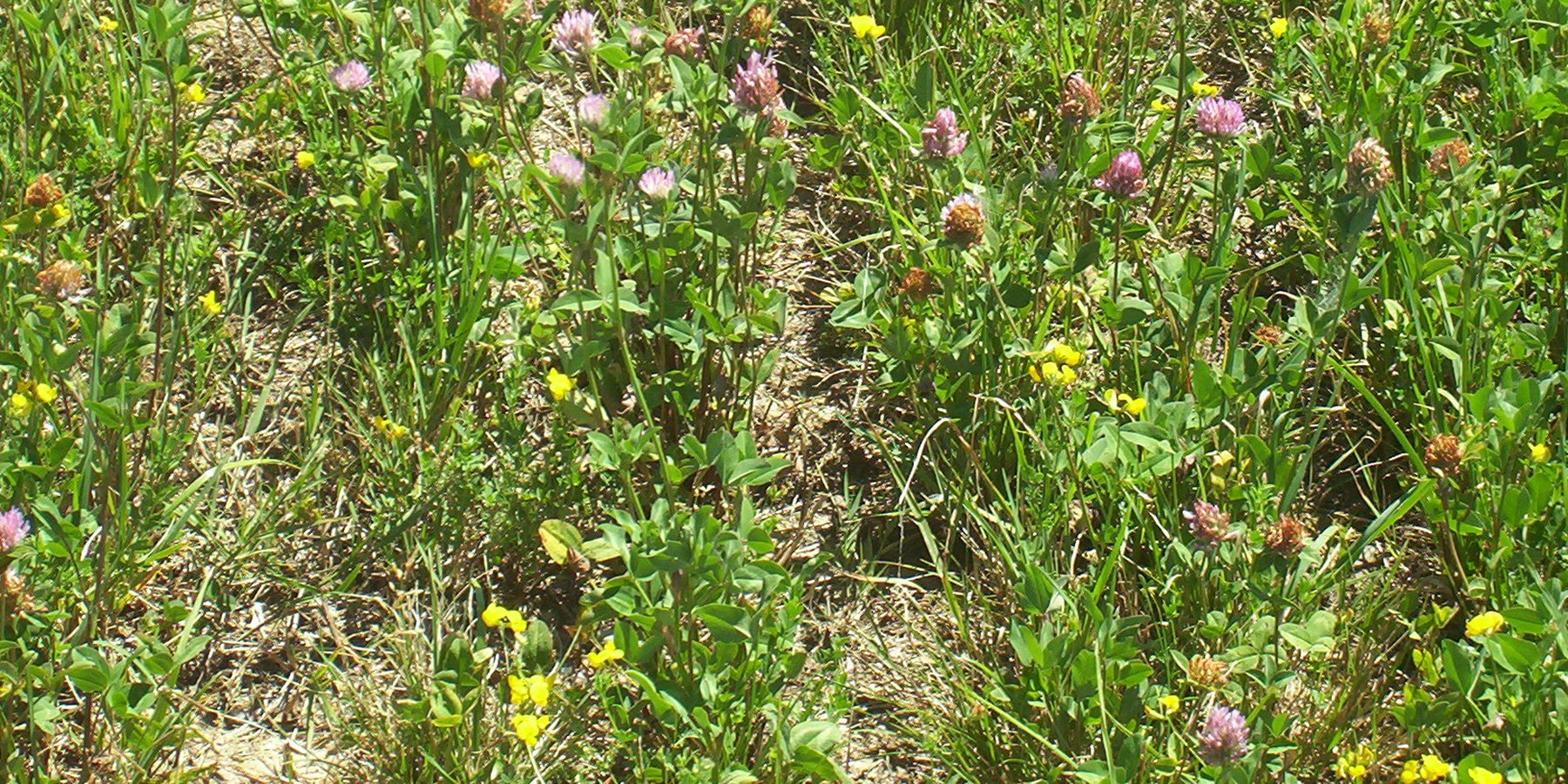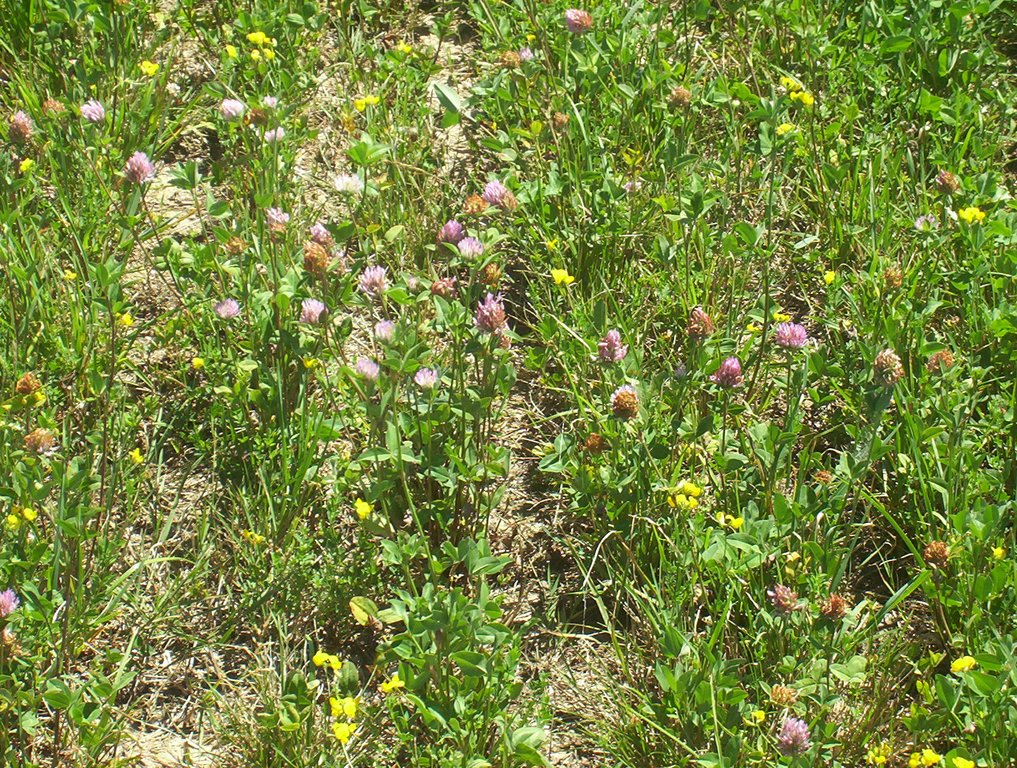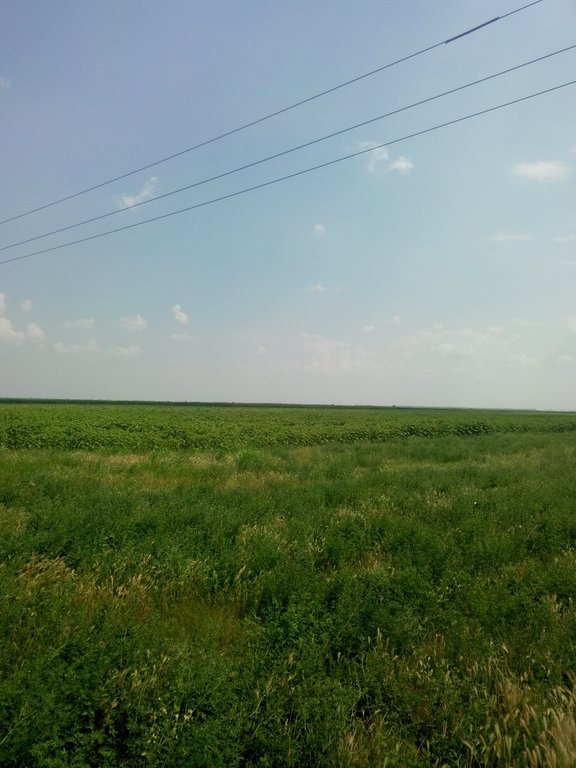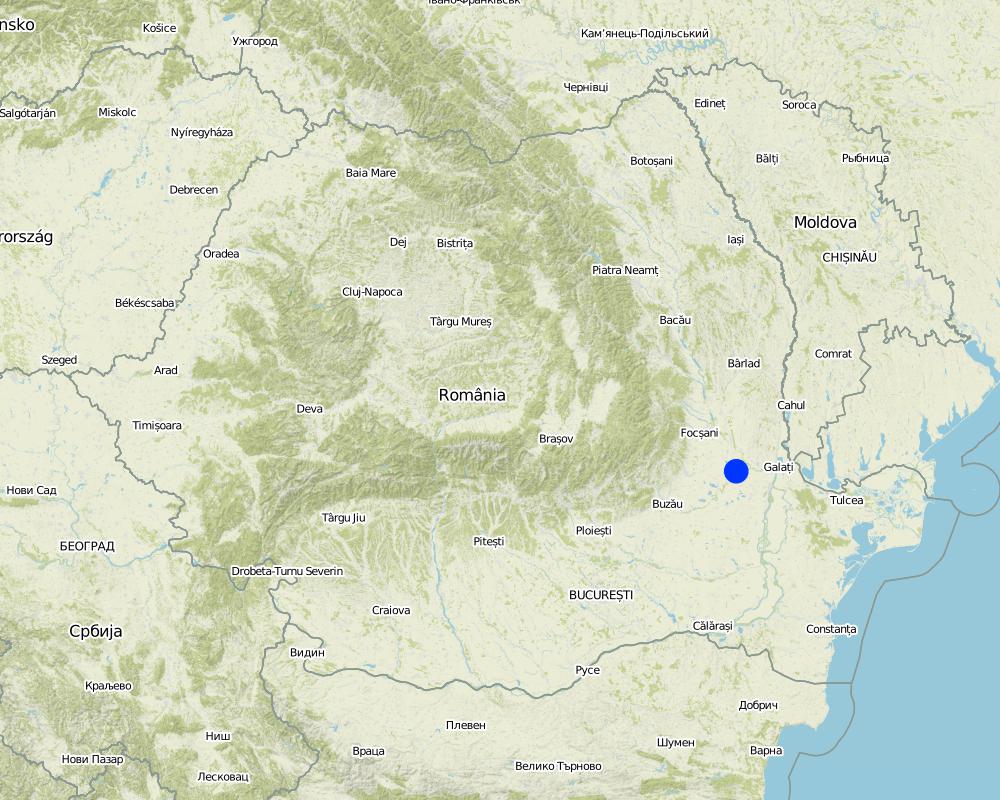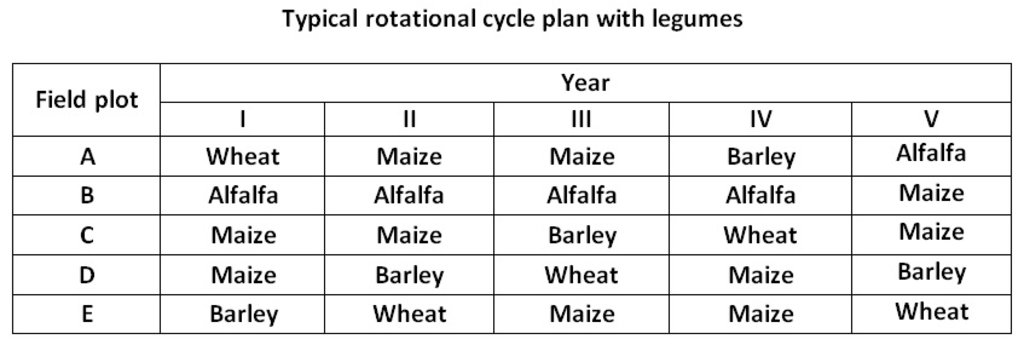Leguminous crop cultivated in plot temporarely set outside the crop rotation [Romania]
- Creation:
- Update:
- Compiler: Olga Vizitiu
- Editor: –
- Reviewers: Ursula Gaemperli, Gudrun Schwilch, Nina Lauterburg, Alexandra Gavilano
technologies_2963 - Romania
View sections
Expand all Collapse all1. General information
1.2 Contact details of resource persons and institutions involved in the assessment and documentation of the Technology
Name of project which facilitated the documentation/ evaluation of the Technology (if relevant)
Interactive Soil Quality assessment in Europe and China for Agricultural productivity and Environmental Resilience (EU-iSQAPER)Name of the institution(s) which facilitated the documentation/ evaluation of the Technology (if relevant)
National Research and Development Institute for So (National Research and Development Institute for So) - Romania1.3 Conditions regarding the use of data documented through WOCAT
The compiler and key resource person(s) accept the conditions regarding the use of data documented through WOCAT:
Yes
1.4 Declaration on sustainability of the described Technology
Is the Technology described here problematic with regard to land degradation, so that it cannot be declared a sustainable land management technology?
No
2. Description of the SLM Technology
2.1 Short description of the Technology
Definition of the Technology:
Introducing the leguminous crops in crop rotation to improve soil fertility, as field plot set temporarely outside the crop rotation. Crop rotation with legumes is an alternative to rotation containing only cereals.
2.2 Detailed description of the Technology
Description:
The technology is applied in Braila region and is located in north-eastern part of Romanian Plain. It has an agricultural area of 387,646 ha (of which 350,001 ha are arable land), and has specific geomorphologic, hydrological and climatic conditions which need to use ameliorative agricultural systems. Within Braila County are distinguished the following relief units: Calmatui Plain, part of the Braila Plain (51% from County area) and the Floodplains of Danube (Big Island of Braila), Siret, Buzau and Calmatui rivers (49% from County area).
Braila Plain is characterized by a specific micro-relief of Baragan type with large floodplains, poorly fragmented, with altitudes ranging between 20-25 m in the east part and 35-40 m to the west part, with soils mainly of chernozem type, formed on loess and loess deposits and which shows numerous small depression areas. Floodplains, areas adjacent to Danube, Siret, Buzau and Calmatui rivers are located at lower altitudes, ranging between 2-4 m and 13-15 m and are characterized by the presence of alluvial soils formed on river-limnic and alluvial deposits, with alternating of layers with different textures. According to United Nations Convention to Combat Desertification, Braila County is located in arid region with an average annual temperature of 10.9°C, long-term average annual precipitations (P) of 447 mm, potential evapotranspiration (ETP) of 705 mm (750-800 mm in dry years) and an average climatic water deficit of 258 mm (350-400 mm in dry years). The biophysical aridity index (P/ETP = 0.50-0.65) places the Braila region in area with moderate risk to desertification. Both intensive and extensive farming systems are practiced within Braila County. Intensive agriculture, characterized by high inputs and yield levels, is realized on large vegetal farms. On the other hand, extensive agriculture, with low input and yield levels, is practiced by farmers on small vegetal farms, and is so-called the semi-subsistent agriculture.
Crop rotation with legumes (such as alfalfa) is is generally limited to a maximum period of time of 5 to 6 years, providing a plant succesion of spring (generally maize, soybean, sunflower) and winter crops (such as wheat, rapeseed, barley). The technology consists of a crop rotation in which one parcel/field plot is cultivated with perennials legumes and set temporarily outside the crop rotation for 4-5 years. During this period, the field plot cultivated with perennials legumes recovers its fertility by improving the soil aeration status, water infiltration and storage rate and soil aggregate stability. Leguminous crops play an important role in crop rotation because it favors the fixation of atmospheric nitrogen and bind it into the soil with a significant increase in soil fertility. Crop rotation with legumes reduces the biocides use because it breaks the pest cycles and weeds. Leguminous crops also improve the soil structure and its stability, increases water permeability, soil biodiversity and soil quality. At the same time, crop rotation with legumes represents a supplemental income source for land users. After alfalfa baling, this is sold to the nearby livestock breeders.
Crop rotation with legumes has many advantages, such as increase of soil agro-ecosystem biodiversity, reduction of chemical inputs, reduction of soil structure degradation processes, increase of nutrient availability and consequently increase of soil fertility, and increase of farm income. Also in the land user's view, crop rotation with legumes may improve land productivity, even though it increase the costs of inputs and management for crop establishment, and for this reason the land user's awareness is low.
2.3 Photos of the Technology
2.5 Country/ region/ locations where the Technology has been applied and which are covered by this assessment
Country:
Romania
Region/ State/ Province:
Braila
Further specification of location:
Braila
Specify the spread of the Technology:
- evenly spread over an area
If precise area is not known, indicate approximate area covered:
- < 0.1 km2 (10 ha)
Comments:
Documentation of the technology is based on examination of field plot smaller than 0.1 km2.
Map
×2.6 Date of implementation
If precise year is not known, indicate approximate date:
- less than 10 years ago (recently)
2.7 Introduction of the Technology
Specify how the Technology was introduced:
- through land users' innovation
3. Classification of the SLM Technology
3.1 Main purpose(s) of the Technology
- improve production
- reduce, prevent, restore land degradation
3.2 Current land use type(s) where the Technology is applied

Cropland
- Annual cropping
Annual cropping - Specify crops:
- cereals - barley
- cereals - maize
- fodder crops - alfalfa
Number of growing seasons per year:
- 1
Comments:
crop rotation of 5-6 years, with one field plot set temporarely outside the crop rotation cultivated with perennial legumes (alfalfa)
3.4 Water supply
Water supply for the land on which the Technology is applied:
- rainfed
3.5 SLM group to which the Technology belongs
- rotational systems (crop rotation, fallows, shifting cultivation)
- integrated soil fertility management
3.6 SLM measures comprising the Technology

agronomic measures
- A2: Organic matter/ soil fertility
Comments:
Introducing of a perennial crop (alfalfa) in a crop rotation with cereals
3.7 Main types of land degradation addressed by the Technology

chemical soil deterioration
- Cn: fertility decline and reduced organic matter content (not caused by erosion)

physical soil deterioration
- Pu: loss of bio-productive function due to other activities
3.8 Prevention, reduction, or restoration of land degradation
Specify the goal of the Technology with regard to land degradation:
- reduce land degradation
4. Technical specifications, implementation activities, inputs, and costs
4.1 Technical drawing of the Technology
Technical specifications (related to technical drawing):
The technology consists of a crop rotation in which one parcel/field plot is cultivated with perennial crop (alfalfa) and set temporarily outside the crop rotation for 4-5 years. During this period, the field plot cultivated with perennial crop recovers its fertility by improving the soil aeration status, water infiltration and storage rate and soil aggregate stability.
After completing one rotational cycling plan, the field plot cultivated with perennial crop will be set in another plot from the crop rotation, until all the plots of the rotation plan will be cultivated with perennial crop.
Author:
National Research and Development Institute for Soil Science, Agrochemistry and Environment (ICPA) - Romania
4.2 General information regarding the calculation of inputs and costs
Specify how costs and inputs were calculated:
- per Technology area
Indicate size and area unit:
1 ha
Specify currency used for cost calculations:
- USD
If relevant, indicate exchange rate from USD to local currency (e.g. 1 USD = 79.9 Brazilian Real): 1 USD =:
4.12
Indicate average wage cost of hired labour per day:
17.60 USD
4.3 Establishment activities
| Activity | Timing (season) | |
|---|---|---|
| 1. | fertilisation | after harvest of previous crop |
| 2. | ploughing | after harvest of previous crop |
| 3. | seedbed preparation | after ploughing |
| 4. | alfalfa sowing | autumn |
| 5. | fertilisation | spring |
| 6. | chemical weeds control | spring - summer |
| 7. | pest control | spring - summer |
| 8. | alfalfa cutting | summer |
| 9. | alfalfa baling | summer |
4.4 Costs and inputs needed for establishment
| Specify input | Unit | Quantity | Costs per Unit | Total costs per input | % of costs borne by land users | |
|---|---|---|---|---|---|---|
| Labour | labor | person-days | 3.0 | 17.6 | 52.8 | 100.0 |
| Equipment | fertilisation | machine-hours | 1.0 | 13.37 | 13.37 | 100.0 |
| Equipment | ploughing | machine-hours | 3.0 | 12.39 | 37.17 | 100.0 |
| Equipment | seedbed preparation | machine-hours | 2.0 | 19.67 | 39.34 | 100.0 |
| Equipment | alfalfa sowing | machine-hours | 1.0 | 17.32 | 17.32 | 100.0 |
| Equipment | fertilisation | machine-hours | 1.0 | 13.37 | 13.37 | 100.0 |
| Equipment | herbicides & pests control | machine-hours | 2.0 | 8.4 | 16.8 | 100.0 |
| Equipment | alfalfa cutting | machine-hours | 1.0 | 50.96 | 50.96 | 100.0 |
| Equipment | alfalfa baling | machine-hours | 2.0 | 36.4 | 72.8 | 100.0 |
| Plant material | alfalfa seeds | kg/ha | 22.0 | 6.12 | 134.64 | 100.0 |
| Fertilizers and biocides | complex fertilizers | kg/ha | 150.0 | 0.28 | 42.0 | 100.0 |
| Fertilizers and biocides | ammonium nitrate | kg/ha | 200.0 | 0.14 | 28.0 | 100.0 |
| Fertilizers and biocides | herbicides | l/ha | 0.5 | 13.75 | 6.88 | 100.0 |
| Fertilizers and biocides | biocides | l/ha | 0.1 | 110.55 | 11.05 | 100.0 |
| Total costs for establishment of the Technology | 536.5 | |||||
| Total costs for establishment of the Technology in USD | 130.22 | |||||
4.5 Maintenance/ recurrent activities
| Activity | Timing/ frequency | |
|---|---|---|
| 1. | fertilisation | spring |
| 2. | herbicides & pests control | spring - summer |
| 3. | alfalfa cutting | summer |
| 4. | alfalfa baling | summer |
4.6 Costs and inputs needed for maintenance/ recurrent activities (per year)
| Specify input | Unit | Quantity | Costs per Unit | Total costs per input | % of costs borne by land users | |
|---|---|---|---|---|---|---|
| Labour | labor | person-days | 1.0 | 17.6 | 17.6 | 100.0 |
| Equipment | fertilisation | machine-hours | 1.0 | 13.37 | 13.37 | 100.0 |
| Equipment | herbicides & pests control | machine-hours | 2.0 | 8.4 | 16.8 | 100.0 |
| Equipment | alfalfa cutting | machine-hours | 1.0 | 50.96 | 50.96 | 100.0 |
| Equipment | alfalfa baling | machine-hours | 2.0 | 36.4 | 72.8 | 100.0 |
| Fertilizers and biocides | ammonium nitrate | kg/ha | 200.0 | 0.14 | 28.0 | 100.0 |
| Fertilizers and biocides | herbicides | l/ha | 0.5 | 13.75 | 6.88 | 100.0 |
| Fertilizers and biocides | biocides | l/ha | 0.1 | 110.55 | 11.05 | 100.0 |
| Total costs for maintenance of the Technology | 217.46 | |||||
| Total costs for maintenance of the Technology in USD | 52.78 | |||||
4.7 Most important factors affecting the costs
Describe the most determinate factors affecting the costs:
Certified seed material and costs with alfalfa cutting and baling are the most determining factors affecting the costs.
5. Natural and human environment
5.1 Climate
Annual rainfall
- < 250 mm
- 251-500 mm
- 501-750 mm
- 751-1,000 mm
- 1,001-1,500 mm
- 1,501-2,000 mm
- 2,001-3,000 mm
- 3,001-4,000 mm
- > 4,000 mm
Specify average annual rainfall (if known), in mm:
447.00
Agro-climatic zone
- semi-arid
5.2 Topography
Slopes on average:
- flat (0-2%)
- gentle (3-5%)
- moderate (6-10%)
- rolling (11-15%)
- hilly (16-30%)
- steep (31-60%)
- very steep (>60%)
Landforms:
- plateau/plains
- ridges
- mountain slopes
- hill slopes
- footslopes
- valley floors
Altitudinal zone:
- 0-100 m a.s.l.
- 101-500 m a.s.l.
- 501-1,000 m a.s.l.
- 1,001-1,500 m a.s.l.
- 1,501-2,000 m a.s.l.
- 2,001-2,500 m a.s.l.
- 2,501-3,000 m a.s.l.
- 3,001-4,000 m a.s.l.
- > 4,000 m a.s.l.
Indicate if the Technology is specifically applied in:
- not relevant
5.3 Soils
Soil depth on average:
- very shallow (0-20 cm)
- shallow (21-50 cm)
- moderately deep (51-80 cm)
- deep (81-120 cm)
- very deep (> 120 cm)
Soil texture (topsoil):
- medium (loamy, silty)
Soil texture (> 20 cm below surface):
- medium (loamy, silty)
Topsoil organic matter:
- medium (1-3%)
5.4 Water availability and quality
Ground water table:
5-50 m
Availability of surface water:
medium
Is water salinity a problem?
No
Is flooding of the area occurring?
No
5.5 Biodiversity
Species diversity:
- medium
Habitat diversity:
- medium
5.6 Characteristics of land users applying the Technology
Sedentary or nomadic:
- Sedentary
Market orientation of production system:
- mixed (subsistence/ commercial)
Off-farm income:
- less than 10% of all income
Relative level of wealth:
- poor
Individuals or groups:
- individual/ household
Level of mechanization:
- mechanized/ motorized
Gender:
- men
Age of land users:
- middle-aged
Indicate other relevant characteristics of the land users:
The technology was firstly implemented by the farmer in the year of 2008.
5.7 Average area of land used by land users applying the Technology
- < 0.5 ha
- 0.5-1 ha
- 1-2 ha
- 2-5 ha
- 5-15 ha
- 15-50 ha
- 50-100 ha
- 100-500 ha
- 500-1,000 ha
- 1,000-10,000 ha
- > 10,000 ha
Is this considered small-, medium- or large-scale (referring to local context)?
- medium-scale
5.8 Land ownership, land use rights, and water use rights
Land ownership:
- individual, not titled
- individual, titled
Land use rights:
- leased
5.9 Access to services and infrastructure
health:
- poor
- moderate
- good
education:
- poor
- moderate
- good
technical assistance:
- poor
- moderate
- good
employment (e.g. off-farm):
- poor
- moderate
- good
markets:
- poor
- moderate
- good
energy:
- poor
- moderate
- good
roads and transport:
- poor
- moderate
- good
drinking water and sanitation:
- poor
- moderate
- good
financial services:
- poor
- moderate
- good
6. Impacts and concluding statements
6.1 On-site impacts the Technology has shown
Socio-economic impacts
Production
fodder production
Comments/ specify:
Increases competition among feed suppliers in the nearby area, so the animal breeders can have more options of sources from which they can buy feed for animals.
product diversity
Comments/ specify:
By introducing the alfalfa crop in rotation, the land user diversifies the farm crop plan and also increases the income of the farm by selling alfalfa balls to the nearby animal breeders.
Income and costs
diversity of income sources
Comments/ specify:
The hay baling production and selling of the hay bales outside the farm is an additional source of income for the land user.
Socio-cultural impacts
SLM/ land degradation knowledge
Comments/ specify:
The land user gains knowledge concerning the efficiency of alfalfa in soil protection against degradation processes such as soil organic matter loss.
Ecological impacts
Soil
soil organic matter/ below ground C
Comments/ specify:
Cultivation of the alfalfa improves the soil organic matter content.
Biodiversity: vegetation, animals
beneficial species
Comments/ specify:
Alfalfa plants are attractive to pollinators.
pest/ disease control
Comments/ specify:
Crop rotation with legumes reduces the biocides use because it breaks the pest cycles and weeds.
6.3 Exposure and sensitivity of the Technology to gradual climate change and climate-related extremes/ disasters (as perceived by land users)
Gradual climate change
Gradual climate change
| Season | increase or decrease | How does the Technology cope with it? | |
|---|---|---|---|
| annual temperature | increase | well | |
| annual rainfall | decrease | well |
Climate-related extremes (disasters)
Meteorological disasters
| How does the Technology cope with it? | |
|---|---|
| local rainstorm | well |
6.4 Cost-benefit analysis
How do the benefits compare with the establishment costs (from land users’ perspective)?
Short-term returns:
neutral/ balanced
Long-term returns:
slightly positive
How do the benefits compare with the maintenance/ recurrent costs (from land users' perspective)?
Short-term returns:
neutral/ balanced
Long-term returns:
positive
6.5 Adoption of the Technology
- single cases/ experimental
Of all those who have adopted the Technology, how many did so spontaneously, i.e. without receiving any material incentives/ payments?
- 91-100%
Comments:
One land user has implemented the technology voluntary.
6.6 Adaptation
Has the Technology been modified recently to adapt to changing conditions?
No
6.7 Strengths/ advantages/ opportunities of the Technology
| Strengths/ advantages/ opportunities in the land user’s view |
|---|
| Improve land productivity |
| Strengths/ advantages/ opportunities in the compiler’s or other key resource person’s view |
|---|
| Improve soil fertility, soil structure, organic matter content and biodiversity. |
| Improve natural control of the weeds. |
6.8 Weaknesses/ disadvantages/ risks of the Technology and ways of overcoming them
| Weaknesses/ disadvantages/ risks in the land user’s view | How can they be overcome? |
|---|---|
| Increase costs of inputs and management for crop establishment | increase awareness on long-term about soil benefits and subsidies |
| Land users awareness is low | education and training |
| Weaknesses/ disadvantages/ risks in the compiler’s or other key resource person’s view | How can they be overcome? |
|---|---|
| no weakness from compiler's view |
7. References and links
7.1 Methods/ sources of information
- field visits, field surveys
1
- interviews with land users
1
When were the data compiled (in the field)?
20/06/2017
Links and modules
Expand all Collapse allLinks
No links
Modules
No modules


